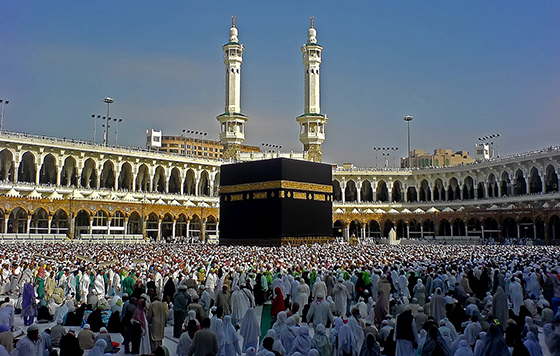Prayer and pilgrimage
Pilgrimage to a holy site is a core principle of almost all faiths. The Kaaba, meaning cube in Arabic, is a square building elegantly draped in a silk and cotton veil. Located in Mecca, Saudi Arabia, it is the holiest shrine in Islam.
In Islam, Muslims pray five times a day and after 624 CE, these prayers were directed towards Mecca and the Kaaba rather than Jerusalem; this direction—or qibla in Arabic—is marked in all mosques and enables the faithful to know in which direction they should pray. The Qur‘an established the direction of prayer.
All Muslims aspire to undertake the hajj, or the annual pilgrimage, to the Kaaba once in their lives if they are able. Prayer five times a day and the hajj are two of the five pillars of Islam, the most fundamental principles of the faith.
Upon arriving in Mecca, pilgrims gather in the courtyard of the Masjid al-Haram around the Kaaba. They then circumambulate—tawaf in Arabic—or walk around the Kaaba, during which they hope to kiss and touch the Black Stone—al-Hajar al-Aswad—embedded in the eastern corner of the Kaaba.
The history and form of the Kaaba
The Kaaba was a sanctuary in pre-Islamic times. Muslims believe that Abraham—known as Ibrahim in the Islamic tradition—and his son, Ismail, constructed the Kaaba. Tradition holds that it was originally a simple unroofed rectangular structure. The Quraysh tribe, who ruled Mecca, rebuilt the pre-Islamic Kaaba in c. 608 CE with alternating courses of masonry and wood. A door was raised above ground level to protect the shrine from intruders and flood waters.
Muhammad was driven out of Mecca in 620 CE to Yathrib, which is now known as Medina. Upon his return to Mecca in 629/30 CE, the shrine became the focal point for Muslim worship and pilgrimage. The pre-Islamic Kaaba housed the Black Stone and statues of pagan gods. Muhammad reportedly cleansed the Kaaba of idols upon his victorious return to Mecca, returning the shrine to the monotheism of Ibrahim. The Black Stone is believed to have been given to Ibrahim by the angel Gabriel and is revered by Muslims. Muhammad made a final pilgrimage in 632 CE, the year of his death, and thereby established the rites of pilgrimage.
Livequranforkids
We are providing the educational service of Learn quran
online, female quran teacher,quran for kids, quran reading,
quran memorization for kids, quran translation,online quran,
quran for kids in USA, quran online and Online quran academy.

No comments:
Post a Comment